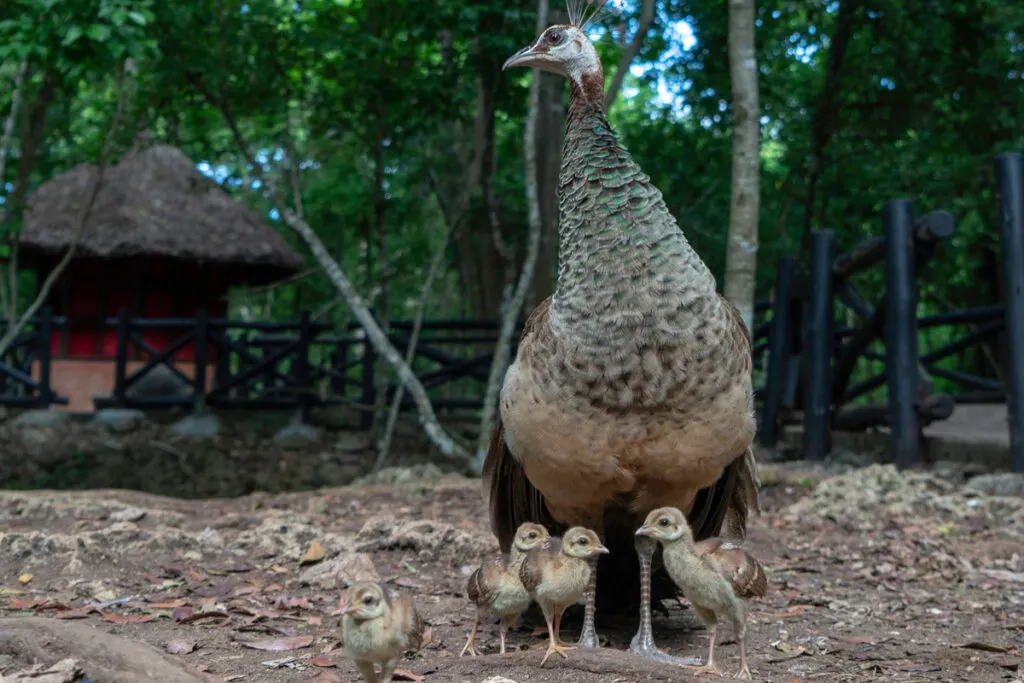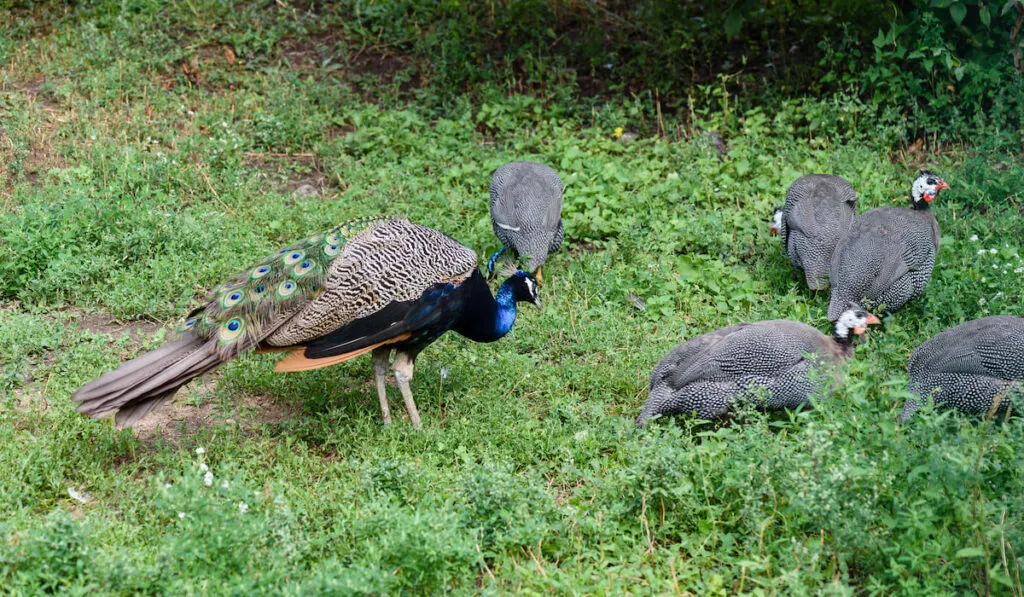Peacocks are very beautiful birds. The sight of a peacock is enough to put a smile on your face.
When you are raising peacocks, you need to be careful so that your birds can grow beautiful and healthy. The slightest mistake when raising peacocks can cost you a lot.
What are some reasons your peachicks are dying? Here are a few things to look out for:
Table of Contents
1. Peachicks eating contaminated food

This is a very common cause of death in peachicks. Contaminated food can mean various things. The following foods are contaminated and not suitable for peachick consumption:
- Moldy foods: Mold is a type of fungi, so mold in food indicates that the food is rotting. Fungi and the toxins they produce in moldy foods are very harmful to peachicks, so you want to dispose of moldy foods correctly or throw them into a compost pile.
- Unwashed Fruits and Vegetables: Even though adult birds can eat some unwashed fruits and vegetables, your peachicks do not have enough immunity against microbes present in such foods. You should always wash fruit and vegetable treats before giving them to your peachicks.
- Unclean Water and Feed on Dirty Trough: You already know how harmful these are for your peachicks.
Contaminated food can contain toxins, bacteria, fungi, etc. that harm peachicks, so make sure that you carefully observe and regulate every food your peachicks eat.
2. Disease
Getting an infection or disease can kill your peachicks. Examples of common peachick infections are:
- Parasites: Peachicks can get both external and internal parasites. Examples of peachick parasites are nematodes, ticks, mites, etc.
- Respiratory Diseases: Diseases such as Newcastle disease, smallpox, etc. are killers of peachicks and are very difficult to treat when your peachicks show symptoms.
- Coccidiosis: Coccidiosis is a protozoan parasite of young birds including peachicks. It can cause diarrhea, ruffled feathers, etc.
Don’t worry, you will learn how to prevent diseases later in this article.
3. Peachicks being bullied by bigger birds
This is common if you are raising multiple species of birds. When you newly release your peachicks out of their brooder box, other birds in the yard such as chickens and ducks might bully your peachicks because they are still young and small.
Aside from raising your peachicks with their mothers, a great way to prevent other birds from bullying your peachicks is when introducing your peachicks into the yard, make a demarcation like a wooden fence or mesh through which other birds can see the chicks, but not reach them.
Your peachicks should be in their compartment for 7-10 days before you fully release them. This will help your peachicks to be known by other birds to prevent bullying.
Other ways to prevent bullying will be shared later in this article.
4. Some peachicks die when not raised by their mother

Many homesteaders have acknowledged that they have more peachick deaths recorded when they brood their peachicks by themselves instead of allowing the mother peahen to brood her chicks. Mother peahens can teach peachicks what to eat, how to eat, when to go back inside, etc. (source)
Brooding your peachicks yourself might prevent them from learning some life-saving skills quickly. For example, they may not quickly go back inside when it’s raining and that can affect their temperature.
Mother peahens also know what plants, bugs, caterpillars, etc. to eat and those to avoid. You do not want your peachicks to know what food to avoid too late.
5. Not eating the right food (nutrient deficiency)
This is a cause of peachick death that is very easy to prevent, but some people still make mistakes. Peachicks have distinct nutrient needs when compared to that of other birds such as chickens and ducks.
One important nutrient to consider when raising peacocks is protein. Protein helps peachicks to grow feathers, become matured (develop sexually), grow and repair tissues, etc.
Because of their feathers (which are made of a hard protein called keratin), peachicks need to consume more proteins than other birds.
Peacocks need 19-28% crude proteins in their diet according to their age (peachicks need 26-28% protein). Chickens need 15-12%. Can you see the difference? What happens when you feed your peachicks with chicken feed?
This is why homesteaders are advised to feed their peacocks with feed made for peacocks, turkeys (which can contain 19-27% protein), and other gamebirds.
Aside from proteins, peachicks have vitamin, mineral, carbohydrate, etc. needs that should be met. Allowing your peachicks to forage for food and also providing them with quality processed feed will prevent the death of peachicks caused by nutrient deficiency.
6. Your peachicks are not getting the right temperature

Always make sure that the temperature is just right especially for your young peachicks (those below 6-8 weeks of age). Even though birds are warm-blooded, they usually depend on external heat for the first few weeks of their life before they can regulate their temperature.
Temperature (specifically heat) is needed for the metabolism of your birds. This means that your birds may grow poorly, become ill, and die when the temperature is just low.
In their first week after hatching, peachicks need a temperature of about 95 °f. After their first week, their temperature need reduces by 5 °F weekly until they have enough feathers (which will help them to cope with room temperature).
7. You bought weak peachicks
It is important that you carefully observe new peachicks before taking them home. If everything is just right and you still find your peachicks dying, it could mean that you bought weak and unhealthy peachicks.

How Do You Prevent Your Peachicks from Dying?
Use the tips below to raise healthy and happy peacocks:
1. Install heat lamps and carefully observe your peachicks
Remember that temperature is a very important factor to consider especially if you are brooding your peachicks yourself (i.e. they are not with their mother). You should install heat lamps as heat sources and observe your peachicks for the following behavior:
- Your Peachicks Are Clustered: When your peachicks are clustered especially near the heat lamp, it means that you need to increase the temperature. You can increase the temperature by lowering the heat lamp, increasing its intensity, or installing more heat lamps. Make sure that the brooder box is carefully insulated with bedding.
- Most of Your Peachicks Are Running Away from the Heat Lamp: If you observe that most of your peachicks are closer to the wall of the brooder box than the heat lamp, it means that the temperature is too high for them. You should reduce the heat or adjusting the height of the bulb.
- Your Peachicks Are Evenly Distributed: You have yourself happy peachicks with just the right balance of temperature.
Always make sure that your peachicks have just the right temperature in the brooder box.
2. Always monitor where your peachicks go
Make sure that your peachicks do not go close to your waste bins or places with contaminated items that peachicks can eat. Also, you should always wash the feeding and water trough of your peachicks to get rid of germs and other pests.
Restricting your peachicks from going to various places can also protect them from predators, bullies, and thieves.
3. Raise your peachicks with their mothers
You should allow your peahens to raise their chicks. Don’t worry. Peahens are great mothers who try to provide everything their chicks need. Here are some awesome reasons you should allow your peahens to raise their chicks:
- Prevent Other Birds from Bullying Your Peachicks: Mother peahens will fight other birds for their chicks. With their mother around, your peachicks are safe from bullies.
- Help Teach Your Peachicks What They Can and Cannot Eat: As you already know, your peachicks will learn faster when they are raised by their mother.
If you do not have peahens or need to brood your peachicks yourself, it will be in your best interest to ask an expert homesteader for help (especially if you are raising the birds for the first time).
4. Vaccinate your peachicks or feed them with medicated feed
Vaccines are products that contain non-lethal forms of diseases that can kill your peachicks. The purpose of vaccines is to help your peachicks develop strong immunity against such diseases.
With vaccines, you can prevent Newcastle disease, smallpox, etc. from killing your peachicks.
You should also feed your peachicks with medicated feed especially when you have recorded some deaths in the past.
5. Be extra careful during winter
Winter can be a difficult time of year for a homesteader. Extra care must be taken to make sure your peachicks have what they need to survive the colder weather.
Use the tips below to keep your peachicks safe during the winter:
- Carefully Insulate the Pen: You can line the pen or coop with an insulating material such as Styrofoam. Make sure that there is a thick layer of bedding to prevent the legs of your peachicks from touching the ground. Also, window slits should be close to the roof of the pen, not below.
- Give Your Peachicks A Lot of Grains: Digesting grains produces a lot of heat. To keep your peachicks warm during the winter, give them grains (especially at night when you may not be around to keep an eye on them).
- Give Your Peachicks A Green Piñata: A green piñata is simply cabbage or another similar vegetable that is hung to the roof of the pen. Giving your peachicks a green piñata is a fun and healthy way to keep them active in winter.
Can your peacocks go out during the winter? It depends on their age and what you want. If your peacocks have enough feathers, you can allow them to go out. You must, however, observe them to make sure that they are okay.

Related Questions and Answers
1. Can you raise peachicks and chicks (baby chickens) together?
Remember that peachicks and chicks have different protein needs, so if you must raise them together, you need to separate their feed and make sure that your peachicks do not eat the feed of your chicks.
You can allow your chicks to eat from your peachick feed but note that it will be expensive to feed both bird species with the expensive feed of peacocks.
Chicks will develop and grow feathers faster than peachicks, so your chicks will probably leave the brooder box before your peachicks.
2. What are recommended bedding materials for a peacock brooder box or pen?
In their first week after hatching, you should use a paper towel, newspaper, or any material that your peachicks cannot peck on and eat.
After their first week, you can switch to any of these:
- Wood Shaving: Wood shaving is great for peachicks as it absorbs a lot of moisture.
- Hay or Straw: These materials are cozy and are as effective as wood shaving.
- Shredded Paper: If you are ready to change their bedding every day, shredded paper is a great idea.
Do not use sawdust except it is dusted.
3. Can a mother hen raise peachicks?
If you can carefully insert your peacock egg in the nest of your hen without her noticing, a mother hen can help incubate and raise your peachick.
You should know that chicken eggs incubate for 21 days while peacock eggs incubate for 30 days. This means that it is not so much of a great idea to give your peacock egg to a chicken.
Final Thoughts
Peachicks are delicate birds. You should raise them as carefully as you can.
Follow the tips in this article to help you raise your birds to be healthy, beautiful, and strong.
